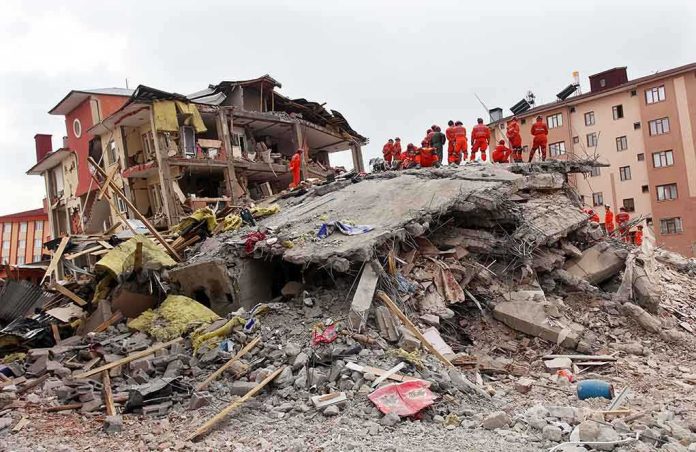
Advanced thermal drones have detected no remaining survivors beneath the crushed concrete and twisted metal that was once a bustling Islamic boarding school in Indonesia, marking the tragic end of a desperate three-day rescue mission.
Story Overview
- Building collapse at Indonesian Islamic boarding school leaves 59 missing and 5 confirmed dead
- Rescue operations shift to recovery phase after thermal drones detect no signs of life
- Five survivors pulled from debris and hospitalized during initial rescue efforts
- Magnitude 6.5 earthquake complicated rescue operations in seismically active region
When Hope Turns to Heartbreak
The National Disaster Mitigation Agency delivered crushing news to families gathered at the disaster site in Sidoarjo, East Java. Agency head Suharyanto announced that high-tech equipment, including thermal imaging drones, had exhausted every scientific method to detect survivors trapped beneath the rubble. The announcement marked 72 hours since the building within the Islamic boarding school compound suddenly collapsed during regular Monday activities.
Thirty ambulances remain positioned at the scene, their crews now tasked with a grimmer purpose than originally intended. What began as an urgent rescue mission has transformed into a methodical recovery operation, with heavy cranes replacing the delicate tools used to search for survivors in the crucial first hours after the collapse.
Technology Meets Tragedy in Modern Disaster Response
The deployment of thermal imaging drones represents a significant advancement in Indonesia’s disaster response capabilities. These sophisticated devices can detect body heat signatures through layers of concrete and debris, providing rescue teams with critical information about potential survivor locations. The technology proved invaluable during the initial rescue phase, helping teams locate and extract five survivors who were subsequently hospitalized.
Despite these technological advantages, the laws of physics and human biology ultimately dictated the outcome. Survival rates in building collapses drop dramatically after the first 72 hours, when dehydration and injury complications become insurmountable obstacles. The thermal drones confirmed what rescue experts privately feared but continued fighting against until scientific evidence left no room for hope.
Seismic Reality Compounds Human Tragedy
The rescue operation faced an additional challenge when a magnitude 6.5 earthquake struck the region during recovery efforts. This seismic event highlighted Indonesia’s precarious position along the Pacific Ring of Fire, where tectonic activity regularly threatens infrastructure and human safety. The earthquake not only complicated rescue operations but also raised questions about whether previous seismic activity may have weakened the school building’s structural integrity.
Indonesia’s history of building collapses often intersects with its seismic vulnerability, creating a recurring pattern of preventable tragedies. The 2006 Yogyakarta earthquake and 2018 Lombok earthquake both exposed widespread structural failures, particularly in older buildings and rapidly constructed facilities. Islamic boarding schools, known locally as pesantren, frequently operate in older buildings or structures built quickly to accommodate growing student populations.
Beyond Statistics: The Human Cost of Structural Failure
Behind the technical details of thermal imaging and seismic activity lies a more fundamental question about institutional responsibility and safety oversight. The collapse occurred during routine activities, suggesting no obvious warning signs that might have prompted evacuation. This raises concerns about building inspection protocols and enforcement mechanisms, particularly for educational institutions housing vulnerable populations.
The transition from rescue to recovery represents more than an operational shift; it acknowledges the harsh reality that 59 families must now prepare for devastating news rather than miraculous reunions. The five survivors serve as both sources of hope and painful reminders of what might have been possible with different structural standards or earlier detection of building vulnerabilities.
Sources:
‘It Seems Impossible’: Mother’s Hope for Son’s Life Dims After Indonesia School Collapse










